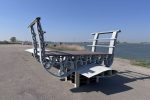Wind Turbine Blade Reused in 3D Printed Modular Bridge
Poly Products, a Dutch company specializing in composite processing, has developed a modular bridge that reuses a decommissioned wind turbine blade as its primary girder. The structure, now installed in Almere, was created as part of the Circular Viaduct program led by the Ministry of Infrastructure and Water Management, which supports pilot initiatives for circular infrastructure across the Netherlands.
The bridge was developed in cooperation with Antea Group, an engineering consultancy; GKB Group, which specializes in ground, road, and waterway infrastructure; and the Amsterdam University of Applied Sciences. The concept emerged after a visit to Eneco’s decommissioning operations at the Herkingen Wind Farm. Blade-Made, a company focused on wind blade repurposing, facilitated access to the LM38.8 turbine blade used in the project.
“We want to demonstrate what is possible,” said Michiel de Bruijcker, managing director of Poly Products. “With our 55 years of experience in processing composite materials, it is interesting to investigate what role we can play in reuse, while preserving the original shape where possible.”
3D printed blade bridge in Almere reuses LM38.8 wind turbine. Photo via Poly Products.
Over the past year, the team worked on developing a full-scale prototype. The completed bridge spans 12 meters, is 3 meters wide, and can occasionally support loads up to 5 tons. Prior to installation, the blade was tested in Heerenveen, where weak points were identified and reinforced. Additional recycled materials were used throughout the structure, including thermoplastic and thermoset components and a deck surface made from repurposed sheet piling.
To accommodate the curved geometry of the wind turbine blade and enable integration with the modular road deck, Poly Products employed large-format 3D printing. Using its in-house production capacity, the company developed customized 3D printed shanks that serve multiple roles. These parts support the deck, secure the handrail, and provide the necessary bridge width. The shanks were designed to ensure mechanical continuity and modular adaptability.
During the design phase, Poly Products engaged various market stakeholders to assess demand. The bridge received positive feedback and was determined to be financially viable at market prices. A patent application for the structural solution is currently pending, and discussions are underway for additional installations based on the same design.
Modular deck with printed shanks and recycled components. Photo via Poly Products.
3D Printed Bridges Showcase Circular Design and Material Reuse in Europe
In Italy, researchers at the Polytechnic University of Bari recently developed a six-meter pedestrian bridge inspired by Leonardo da Vinci’s self-supporting arch design. The structure, called “Da Vinci’s Bridge,” was 3D printed using a specialized mortar made from waste stone powders and lime-based binder. Fabricated in partnership with 3D printing firm WASP and engineered by startup B&Y, the bridge consisted of 13 modular blocks printed using the WASP 3MT LDM Concrete system. The project emphasized sustainable construction through recycled material use and stereotomy-based modular design, offering a precedent for functional reuse of industrial byproducts in civil structures.
In 2021, the city of Nijmegen unveiled what is reportedly the world’s longest 3D printed concrete pedestrian bridge, spanning 29 meters. Developed by Rijkswaterstaat and designer Michiel van der Kley, the bridge was realized through a collaboration with TU Eindhoven, Witteveen+Bos, and manufacturing partners BAM and Weber Beamix. The parametric design enabled optimized structural geometry, while the 3D printing process significantly reduced material use and construction time. The project demonstrated the scalability of 3D printed concrete structures while highlighting their potential for faster, lower-impact infrastructure development.
The Da Vinci Bridge in Action. Photo via Politecnico di Bari, B&Y and WASP.
Ready to discover who won the 20243D Printing Industry Awards?
Subscribe to the 3D Printing Industry newsletter to stay updated with the latest news and insights.
Featured image showcase 3D printed blade bridge in Almere. Photo via Poly Products.
Anyer Tenorio Lara
Anyer Tenorio Lara is an emerging tech journalist passionate about uncovering the latest advances in technology and innovation. With a sharp eye for detail and a talent for storytelling, Anyer has quickly made a name for himself in the tech community. Anyer's articles aim to make complex subjects accessible and engaging for a broad audience. In addition to his writing, Anyer enjoys participating in industry events and discussions, eager to learn and share knowledge in the dynamic world of technology.


